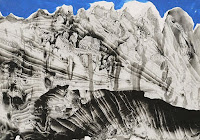 For the second part of your value project, you will be required to apply the skill and knowledge that you have fostered during the creation of your 10-step greyscale.
For the second part of your value project, you will be required to apply the skill and knowledge that you have fostered during the creation of your 10-step greyscale.
Once you have successfully finished your 10-step greyscale, you will need to obtain a color reproduction of an "old master" painting-- the term "old master" typically refers to a European painter of skill who lived and worked from 1470 to 1800. This reproduction must only come from a book or a postcard (in other words it has been professionally printed) and not the internet. The reason for this, is that many digital reproductions incorrectly represent the original color balance and contrast of the works, as images are repeatedly sampled, re-sized, compressed and edited without the knowledge of the original copyright holders. I suggest that you locate at least three images of interest to you-- images that demonstrate a range of color and a dynamic composition. Additionally, your image cannot be a cropped detail of a full work, but must be the entire image. Pay attention so that you do not choose a cropped image.
You will need to bring these images with you into Thursday's class meeting, along with your completed grey scale. This means that you must bring the book or the postcard from which you will arrive at a final image to use. You cannot bring a computer printout or a copy from a Xerox machine. I will be speaking with each of you, one at a time, to discuss your image choice during class. If you do not have an image-- you will receive point deductions.
After you have an image to work with, and receive the go-ahead from me, to create a very simplified line drawing of the work you have chosen, onto a sheet of illustration board (not bristol board) that is at least 10 inches wide. That means you need to include a one by ten inch strip at the bottom of your composition, where you will carefully glue your bristol board greyscale chips down into place-- neat and straight. Then, you are to look at the reproduction of the painting you have chosen, and match it's light and dark areas with the steps of light and dark in your greyscale. That is, consider each step a number (from 1 to 10), and when you match a value to the value in the source painting, you write that number on the corresponding area in the drawing on your illustration board. In other words-- you are making a paint-by-number value translation of an Old Master painting, in order to familiarize yourselves with the compositional uses of light and dark distribution. This exercise will help you see how areas of light and dark can be composed to masterfully guide a viewer through a work. By breaking the composition into shapes of light and dark, you are seeing a painting for its value and compositional makeup, rather than for its subject or "style."
Once you have determined all of the values, you will then need to paint your composition. Do not worry about blending or the need to "forge" a perfect copy of your source. If you do this right, it should actually look much more simplified than the original with stark, graphic shapes, rather than areas of blended subtlety. Look above for some student examples. I also suggest you mix a single value and then paint of of that value out, before moving onto a different value.
Mix your paint gingerly. Meaning-- take care to use small amounts of black-- for it goes a long way. Use only enough paint for a given value. Try to paint with an even hand, as smoothly as possible. These areas of value should be solid and opaque, without any transparency whatsoever.
DUE THURSDAY, MARCH 30 (images are to be emailed, as class will not be meeting on the 30th-- your next assignment will be posted on the 30th, for you to review).










.jpg)
.jpg)
.jpg)
.jpg)
.jpg)





















